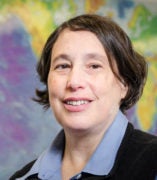
Carol A. Stein, PhD
Professor Emerita
Geophysics, Tectonics
Contact
Building & Room:
2472 SES
Address:
845 West Taylor St.
Office Phone:
Email:
Related Sites:
About
My research covers a range of topics in plate tectonics dealing with the thermal and mechanical evolution of the lithosphere. Heat flow data provide a valuable constraint on the time-dependent thermal structure, and, hence, the evolution of the lithosphere. Thus, one can examine processes that perturb the zeroth order plate cooling to affect the evolution of the oceanic lithosphere, such as hot spots and hydrothermal circulation. Another research thrust includes studying how continental rifts form and fail. My recent research efforts include:
1. Thermal evolution of oceanic lithosphere and hydrothermal circulation. I used heat flow and depth data as a function of lithospheric age to calculate a new reference model (GDH1 = Global Depth and Heat flow model) for oceanic lithosphere that better represents the average observed depth and heat flow with age. The large difference between the observed heat flow and the higher heat flow predicted from thermal models for young (< 50 Ma) crust is interpreted as heat lost by hydrothermal circulation. To transfer this much heat requires that the equivalent of the volume of the entire ocean cycles through the oceanic crust every few million years. My research includes aspects of examining how far fluid flows in the crust and how local conditions can influence the flow.
2. North America's Midcontinent Rift system. Lake Superior and the spectacular scenery around it, as seen in places like Pictured Rocks and Apostle Islands National Lakeshores, result from one of the more important processes shaping our planet - the breaking apart of continents to form new oceans. I and other researchers are studying the spectacular 1.1 billion year old Midcontinent Rift System (MCRS). The rift failed, leaving a 3000 km long belt of volcanic and sedimentary rocks that are exposed in the Lake Superior area but buried by younger rocks above its two major arms that meet in the Lake Superior region. One arm extends southwestward at least as far as Oklahoma, and the other extends southeastward through Michigan to Alabama. Recently I have proposed that it looks like the MCRS formed as part of the rifting of Amazonia (Precambrian northeast South America) from Laurentia (Precambrian North America) and became inactive once seafloor spreading was established. However, unlike most failed continental rifts, it was accompanied by unusually large amounts of volcanism both during and after extension.
Selected Publications
Gunawardana, P.M., Moucha, R., Rooney, T.O., Stein, S., and Stein, C.A., North America’s Midcontinent Rift Magma Volume: a coincidental rendezvous of a plume with a rift, Geology, 50, 1125-1129, 2022, https://doi.org/10.1130/G49913.1
Elling, R., Stein, S., Stein, C.A., Gefeke, K., Three Major Failed Rifts in Central North America: Similar- ities and Differences, GSA Today, 32, 4-11, 2022. https://doi.org/GSATG518A.1
Stein, C.A., Stein, S., Gallahue, M.M., and Elling, R.P., Revisiting hotspots and continental breakup – Updating the classic three-arm model, in Foulger, G.R., Hamilton, L.C., Jurdy, D.M., Stein, C.A., Howard, K.A., and Stein, S., eds., In the Footsteps of Warren B. Hamilton: New Ideas in Earth Science: Geological Society of America Special Paper 553, p. 41-57, 2021, https://doi.org/10.1130/2021.2553(05).
Gallahue, M.M., Stein, S., Stein, C.A., Jurdy, D., Barklage, M., and Rooney, T.O., A compilation of igneous rock volumes at volcanic passive continental margins from interpreted seismic profiles, Marine and Petroleum Geology, 104635, 2020, https://doi.org/10.1016/j.marpet– geo.2020.104635.
Elling, R, Stein, S., Stein, C.A., and Keller, R., Tectonic implications of the gravity signatures of the Midcontinent Rift and Grenville Front. Tectonophysics, 778, 2020, https://doi.org/10.1016/j.tecto.2020.228369.
Malone, D.H., Stein, C.A., Craddock, J.P., Stein, S., and Malone, J., Neoproterozoic Sedimentation in the Laurentian Midcontinent: Detrital Zircon Provenance of the Jacobsville Sandstone, Lake Superior Basin, USA and Canada, Terra Nova, 2020, DOI: 10.1111/ter.12481.
Stein, S., Stein, C., Elling R., Kley, J., Keller, R., Wysession, M., Rooney T., Fredericksen, A., and Moucha, R., Insights from North America’s Failed Midcontinent Rift into the Evolution of Continental Rifts and Passive Continental Margins, Tectonophysics, 744, 403-421, 2018, https://doi.org/10.1016/j.tecto.2018.07.021.
Stein, C.A., Stein, S., Elling, R., Keller, G.R., and Kley, J., Is the “Grenville Front” in the central United States really the Midcontinent Rift?, GSA Today, v. 28, no. 5, 4-10, 2018.
Stein, C. A., and S. Stein, Constraints on hydrothermal heat flux through the oceanic lithosphere from global heat flow, J. Geophys. Res., 99, 3081-3095, 1994.
Stein, C. A., and S. Stein, A model for the global variation in oceanic depth and heat flow with lithospheric age, Nature, 359, 123-129, 1992.
Education
BS, 1978, California Institute of Technology
PhD, 1984, Columbia University
Post-Doctoral Researcher, 1984-1985, Northwestern University